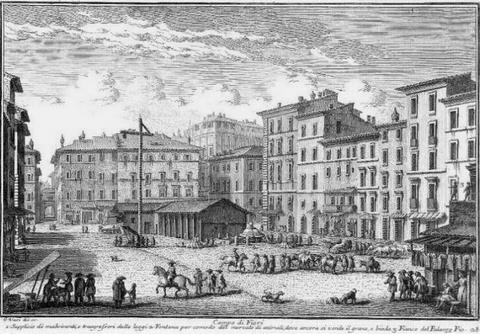Image size reduced due to resolution problems.
| Market place, Gerardo Belfiore (print). Image size reduced due to resolution problems. |
By SAMANTHA LAZAR
Samantha Lazar is a former Philly resident currently residing in Italy.
A man with a dark green hat — one of those flat beret-like hats that only old men wear — is hawking bags of bread. Fifteen rolls for only fifty cents! Even in the streets of Rome, where fresh bread is everywhere you turn, this would be an impossible bargain. This, coupled with the man's ratty coat and three-day stubble, makes me skeptical. Why so cheap? It's yesterday's unused bread from Pat's. Of course. I wonder what the eighteenth-century Italians would think of a cheesesteak.
The 1740's etching of Campo dei Fiori, the square that plays host to Rome's main daily food market, seems remarkably similar to the 1930's image of Philadelphia's Italian market. The Philly image is a mere 80 years old, and the Roman one is almost 200 years older than that, but somehow they seem contemporary, both a world away from the modern day. Campo dei Fiori has been an important market since around 1600, though the horse sales, as well as the public executions and burning of heretical philosophers, have long ago made way for vibrant piles of vegetables and spices. The only livestock in attendance is behind the glass window of the butcher's stall. This market, and ones like it all over Italy, must have been the inspiration for the Italian immigrants that flowed into Philadelphia at the end of the nineteenth century; it's what they had in mind when they set up shop along 9th Street, and it's what felt like home.
 |
| Campo dei Fiori, by Giovanni Vasi |
Vendors huddle around flaming rusted oil drums, awaiting customers and warming their hands, wearing cut-off gloves with exposed fingers — they could be models for a painting of homeless tramps. This seems like what an Italian market should be. But walk around Rome, and past the stalls and restaurants lining Campo Dei Fiori, and modern, sanitized heat wafts from tall gas and electric heaters and washes over you, ensuring the possibility of dining al fresco year-round.
Could it be that the authentic Italian market is in America? That Italy itself has progressed and gentrified, and for a taste of the original one must travel across the Atlantic, following the immigrants' footsteps back in time?
Buckets of olives and bins of cheese — a lunch of samples. Samples, because actually buying a decent-sized wedge of cheese at the 9th Street Di Bruno Bros. would empty my wallet. But in Italy... it's hard to believe that the cheese is even in the same food group as anything tasted on the other side of the ocean — even the expensive, imported stuff. Some kind of reverse alchemy must take place on the journey. There it's still warm from the goat. Or the sheep. Or the buffalo. Rarely the pedestrian cow. And it's as cheap as a pack of bright yellow Kraft Singles. But this is Philly — even Campania buffalo mozzarella, so soft and creamy that you can spread it, somehow doesn't satisfy that hankering for a slathering of Whiz.
Ah, one thing almost the same. Arguably the most important: the heart of the market, the real reason for its existence, actually, both in the streets of Philly and the cobbled piazzas of Italy — the fruits and vegetables. And these, I bet, are the same as they were in 1930's Philadelphia and in 1740's Rome. Glistening, glowing lines of color so bright that one is certain there must be a bleaching agent in supermarket fluorescents that transform American produce into what we usually recognize as tomatoes, eggplants, and zucchini. These are different entirely. Small Pennsylvania farms somehow manage to invest their produce with the flavor and color that should be its birthright. Maybe they're shipping over Italian soil.
Back to main page.